Coinstore
CoinStore Review 2023: An Expert's Comprehensive Analysis
4.2
4.5
4
4
4.1
Overview
General
Fees
Customer service
Requirements & Accessibility
Pros
Is not a well-known, reputable exchange
Only supports 59 cryptocurrencies and 59 trading pairs
Bad customer service – no direct phone number
Does not provide Proof of Reserves”
Cons
A notable amount of security protocols
Available on both desktop and mobile devices
Fast, easy to use mobile app
No notable hacks or breaches
24-hour chat service
Key Takeaways
Origins
Introduction
Singaporean-based cryptocurrency exchange, Coinstore, is known for distributing mainly across Asia and the Middle East. It is said to provide global users with “fast and smooth cryptocurrency trading services, derivatives business, and NFT services.” But, is this enough to set itself apart from its many competitors? That depends on all it has to offer. So, join us at Coinscan as we figure out what this exchange is all about.
History
Founded in 2020 in Singapore, Coinstore was a little later to the game than many of its rivals. However, the business remains a go-to platform for many novices and seasoned traders that are not fussed about having a wide range of cryptocurrencies to pick from.
Following success in Asian markets, the company has also opened headquarters in Asia-Pacific (APAC), the Association of Southeast Asian Nations (ASEAN), and Southeast Asia.
Since 2021, it has also been a reputable exchange in India due to allocating USD $20 million for its India expansion – spending these funds mainly on marketing, hiring talent, and developing crypto-related products and services related to their market regardless of conflict, but more about that later!

One thing that makes the exchange stand out is that, unlike many Web3 companies, a female leader, Jennifer Lu, runs it. Consequently, Lu takes pride in attending women at blockchain events due to the industry currently being disproportionately male. Following this, she understands the need to balance the scales and is known for going out of her way to continuously network and meet up with like-minded businesswomen in the crypto sphere. She is also an active commenter on websites such as Bitcoinist and Business Insider, expressing her knowledge in numerous publications to give outsiders more understanding of the space and show off her industry knowledge.
It is important to note, however, that the company is not sexist by any means. Out of the company’s nearly 200 employees, many men help run the business alongside women – all of whom join forces to ensure the company runs safely and efficiently day-to-day.
User Experience
Ease of Use and Design
An important characteristic for any competitive exchange platform is its ease of use and friendly interface design.
The Coinstore interface is controlled through a simple dashboard that gives a user access to different sections such as the market chart, trading tools, and blog among other important features
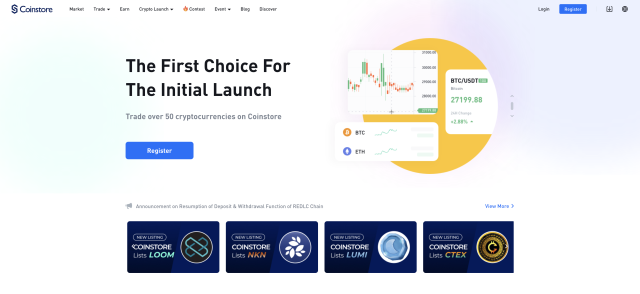
Once clicking home, users can enjoy its friendly navy and white interface and all the exchange’s features:
The Earn feature gives users a chance to earn up to 150% and 11% APR by locking their savings in NUVA and USDT, respectively. On the other hand, its Launchpad benefits those wanting to launch new tokens or projects.
In contrast, the blog is helpful for those wanting announcements about the company’s products. However, unlike other exchanges, it does not offer general educational materials to help better users' trading techniques and provide essential industry news. Instead, it is self-focused, which is likely not of much use.

Like many other exchanges, Coinstore has crypto indicator tools ideal for analyzing and predicting the performance of cryptocurrencies. Such tools provide insights into volatility, trends, and other factors that all affect the value of cryptocurrencies. This helps traders and investors make better decisions when buying or selling particular tokens. Moreover, provided indicators are typically most useful for more advanced traders due to looking extremely confusing and technical at first glance.
However, after some education, anyone can successfully use indicators to help make better choices in their trading.
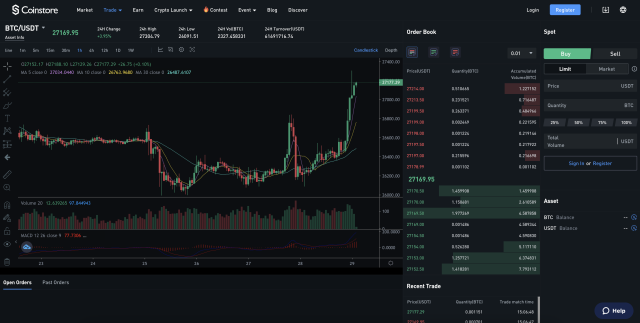
Its NFT marketplace is another asset of the company. The product allows users to purchase, sell and trade digital assets, including artwork, music, and video collectibles. That said this is nothing revolutionary as other exchanges also supply a similar service, making it comparable to the rest of the centralized exchange industry. All of the above features are available on the Coinstore app, available on Google Play and the Apple Store. Despite the company not being as favored as many of its rivals, most feedback regarding the app is surprisingly positive. Users can easily trade the most popular cryptocurrencies while on the move, alongside taking advantage of the fast deposit and withdrawal services.

Usage and Popularity
Although some exchanges have more than 1,000 coins and trading pairs, Coinstore has 140 currencies and 102 trading pairs, making it a much less popular option than others, despite offering all major and reputable currencies the majority of most individuals use.
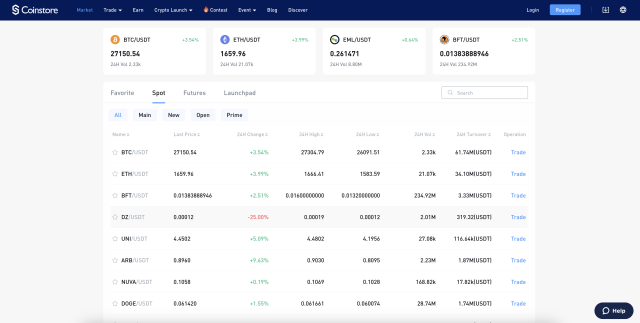
The exchange's volume is not too shabby (all things considered), reportedly being $144,735,345.70 per 24-hours. Similarly to many other exchanges, Coinstore’s most active trading pair is also ETH/USDT, with a 24-hour trading volume of $56,646,858.93.
The exchange is also said to have around 1.1 million registered users across 175 countries. (However, it’s crucial to remember that this information was given by a company other than Coinstore itself, so it may not be the most trustworthy of sources. Coinstore keeps its amount of members secret, and perhaps for a good reason).
Customer support
Although Coinstore has a “Help Center”, it does not include anything out of the ordinary that sets itself apart. Like all other exchanges, it has a FAQ center that answers the most common questions raised by customers, like “How do I find my transaction hash?”, etc. On another note, it has a “Submit a request” section, where users can ask a team member a question if they cannot find the answer in the FAQ section.
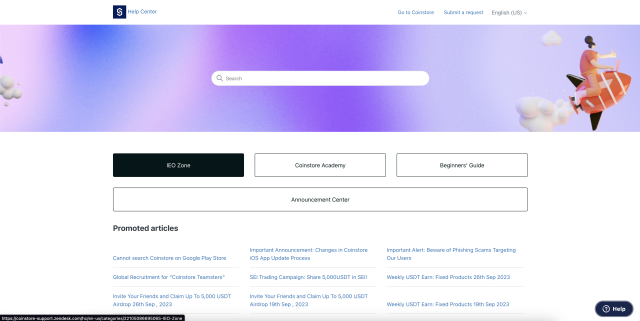
However, most users would rather be able to call a member of the team directly to get issues solved immediately – this is not an option on Coinstore. Luckily for Coinstore, many other exchanges do not offer such services. Therefore, the company gets away with not supplying such a simple support solution. Moreover, it has a chat service at the right of its screen that can ask questions day in and out if needed. Nonetheless, chatbots are usually useless at identifying users' needs, who are traditionally left frustrated and unsatisfied as they go around in circles with the robot without getting the issue solved. In this case, old-school ways are typically the best ways. Be better.
Fees and Promotions
Fees
Unlike many other exchanges whose fees vary depending on which asset they are trading, Coinstore has a set trading fee: maker and taker fees for spot trading are 0.002%, whereas the maker fee for future trading and perpetual contracts is 0.00025%, and the taker fee is 0.0006%.
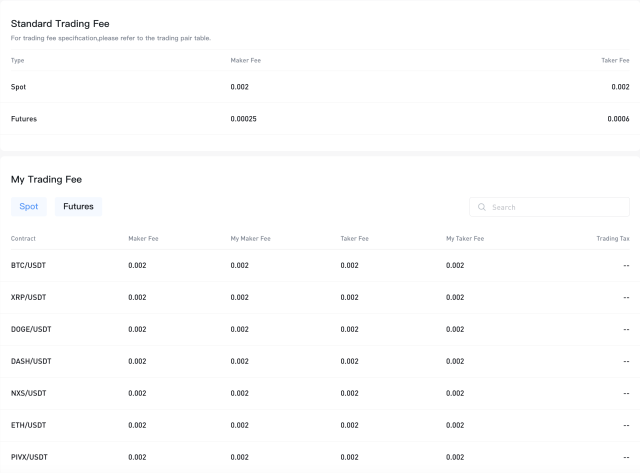
Many users may find having a flat fee for both makers and takers beneficial due to simplifying the fee structure. The variable fee structure isn’t preferred for many traders, with most looking for a simplified and equitable maker/taker structure.
In terms of withdrawal fees, for some bizarre reason, there is just no information on it, either on the site or otherwise. (In fact, we had to get the info for the trading maker /taker fees from a third-party site). It seems the only way to know for sure is to sign-up, which is not a great look, considering most traders want to know what they’re going to pay before they commit.
In addition, there is no fiat deposit or withdrawal service on the platform, which is a huge negative.
Comparison
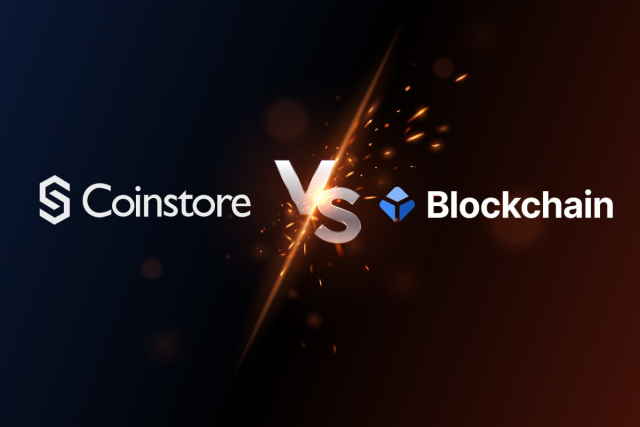
Both Coinstore and Blockchain.com are cryptocurrency exchanges that offer a wide range of features and services. However, there are some key differences between the two platforms, which may make one a better choice for certain users than the other.
If you are a beginner, or if you are looking for an exchange with no fees, then Coinstore is an amazing choice. If you are looking for a global exchange that has more trading features, then Blockchain.com is a contender you should consider.
Safety Essentials
Security
Coinstore has a questionable number of security protocols when entering the exchange for the first time. Unlike many other exchanges, it takes a while for users to gain access due to having to fill out registration forms, among other tasks that may be perceived as unnecessary. However, following common industry issues, it is most likely for the best. Everyone using an exchange will appreciate hearing this tagline, “Security With a Piece of Mind” (the security section's title). Underneath, the exchange explains how it supplies 70% of customer funds in cold storage as a backup in case of theft or loss, among many other security protocols, like multi-step verification.

Multi-step verifications are extremely useful. Rather than users just entering a username and password – which many other businesses accept – Coinstore requires all users to enter a code sent from their mobile phone or email as an extra layer of security. Google authenticators are also accepted.
Thanks to these robust security measures, including a mandatory and tiered approach to KYC, the exchange boasts an impressive history of having no security concerns.
All Coinstore employees must also undergo a criminal background check as a small part of their hiring process. In addition, all team members use separate passwords and two-step certification processes to use the platform's backend services, utilize strong passwords, and enable screen locking to prevent hacks and fraudulent activity.
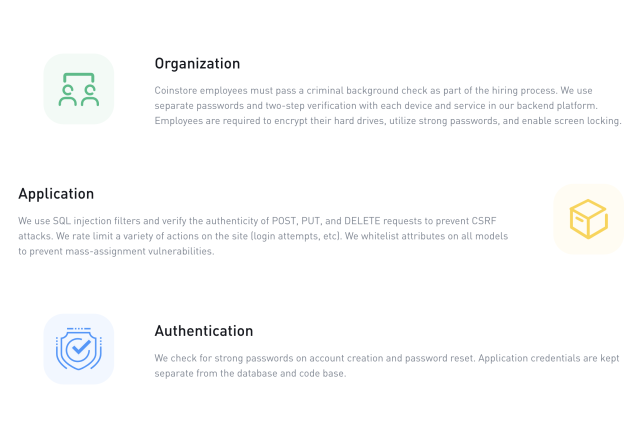
In terms of payment compliance, Coinstore’s website traffic also runs entirely over encrypted SSL (HTTPS), and stores cryptocurrency wallets and private keys using AES-256 encryption. This algorithm is highly considered secure and almost impossible for hackers to crack without social engineering. Even the US government uses it for securing sensitive documentation – now, that’s saying something. Something else to consider is that, because of Coinstore being a Singaporean-based company, it must have suitable security measures in place due to the country having strict supervision and guidelines in place by their regulatory bodies.
Controversy
As mentioned above, Coinstore expanded into the Indian market back in 2021. And this development came with challenges.
The exchange cherry-picked the worst time possible to roll out this expansion – just as the Indian government decided to clamp down on private transactions of cryptocurrencies. Regardless, Coinstore bit the bullet and stuck to its plans, causing a stir as it went on a recruitment spree, branching out in Bangalore, New Delhi, and Mumbai.
The company, of course, received bad press for not respecting the Indian government. Luckily for the company, it got away with it…so well done Coinstore? On a cheerier note, Coinstore, unlike many other exchanges, has managed to dodge the bullet regarding hacks and fraudulent activities – a huge achievement in itself. Pat on the back for Coinstore here.
Proof of Reserves
Despite the potential benefits of publishing Proof of Reserves (PoR), Coinstore, among other exchanges, is yet to release theirs.
The issues that come with not publishing PoR, such as lack of transparency and assurance of custody of funds, can make users question the safety of their assets and cause them to consider other options for trading and storing their digital assets. This negative is a significant disadvantage for Coinstore as this loss of trust can, ultimately, lead to a loss of customers.
In the near future, Coinstore will benefit significantly if providing this level of transparency that gains and maintains the trust of users.
Conclusion
Overall, while digging into all things about this relatively new exchange, it is clear that there’s nothing that makes it stand out among its competitors except an extensive security process for signing up.
Unlike exchange giants – like Binance and Coinbase – it has a measly amount of cryptocurrencies: 140 tokens and 102 trading pairs, and nothing unique regarding trading features. Another issue is that it does not supply its Proof of Reserves, despite being a common requirement nowadays following the FTX shambles. However, being based in Singapore does mean it takes its regulation very seriously.
Another minor positive of this exchange is that it has fixed maker and taker fees for spot trading. But, even so, this is not enough to make the exchange highly desirable when compared to others. Yes, it also has a friendly interface suitable for both new and old traders alike, but so do the majority of other exchanges, which typically offer other advantages on the side, like educational resources and unique trading tools. It doesn’t show withdrawal fees either, and it doesn’t let you deposit or withdraw fiat – a huge downside.

That being said, hats off to Jennifer Lu – an icon in the industry. The founder sticks to her guns and works hard in educating outsiders about the need for Web3 and all it has to offer. As a consequence, she attracts more women into the Web3 world through networking and raising awareness about the gender gap in the industry, which is extremely commendable.
Unfortunately, that isn’t enough for us to be able to fully recommend her exchange. Sorry Jennifer.